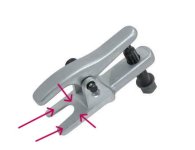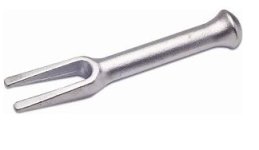@smahaley
I just remembered something else :-
When removing the engine and transmission as one unit, the centre track rod (i.e. the rod between the steering box pitman arm and the idler box arm) needs to be disconnected as it's in front of the clutch bellhousing so it's in the way. This info is in the Haynes Workshop Manual, of which I believe you have a copy?
This centre track rod doesn't have to be disconnected if the engine is being removed on it's own leaving the transmission in the car - my preferred option, which is probably why I forgot to mention this step.
If you don't have a suitable ball joint separator, (most joint separators are designed to fit over the end of a steering arm and may not fit onto the arm when approaching from one side, which is the case here) you could go 'old school' - loosen the ball joint nuts, leave them on by a few threads to protect the threads, place a lever/prybar at an angle between the pitman arm and the centre track rod and while trying to lever them apart, strike the side of the arm sharply with a hammer, adjacent to the ball joint pin to be separated (I don't like doing it this way as there is a risk of damaging the dust boot on the joint). So careful does it... Then separate the other joint. Make a note/sketch of which way around the centre track rod is fitted, most have a slight double offset for clearance reasons.
I just remembered something else :-
When removing the engine and transmission as one unit, the centre track rod (i.e. the rod between the steering box pitman arm and the idler box arm) needs to be disconnected as it's in front of the clutch bellhousing so it's in the way. This info is in the Haynes Workshop Manual, of which I believe you have a copy?
This centre track rod doesn't have to be disconnected if the engine is being removed on it's own leaving the transmission in the car - my preferred option, which is probably why I forgot to mention this step.
If you don't have a suitable ball joint separator, (most joint separators are designed to fit over the end of a steering arm and may not fit onto the arm when approaching from one side, which is the case here) you could go 'old school' - loosen the ball joint nuts, leave them on by a few threads to protect the threads, place a lever/prybar at an angle between the pitman arm and the centre track rod and while trying to lever them apart, strike the side of the arm sharply with a hammer, adjacent to the ball joint pin to be separated (I don't like doing it this way as there is a risk of damaging the dust boot on the joint). So careful does it... Then separate the other joint. Make a note/sketch of which way around the centre track rod is fitted, most have a slight double offset for clearance reasons.
Last edited:




